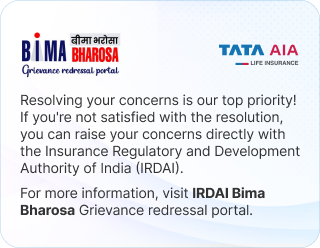1.What are 'current expenses' in the pension calculator?
‘Current expenses’ in the pension calculator is the monthly amount spent to maintain your current standard of living, like housing, groceries, health and other lifestyle-related costs.
2.What are ‘expected post-retirement expenses' in the pension calculator?
‘Expected post-retirement expenses’ in a pension calculator are the amount you expect to spend after you retire, including rent, food, healthcare and discretionary spending like travel.
3.How does a pension calculator help me choose a good retirement plan?
Pension calculators help choose the right retirement plan by estimating your future needs and comparing different investment options based on your age, desired retirement age and expected expenses.
4.Is it necessary to use a retirement calculator?
It is important to use a retirement calculator before planning to invest in a retirement plan for the following:
● Determine an affordable premium for the required annuity amount. ● Find a suitable premium payment term & mode, and annuity option ● Make appropriate long-term financial planning decisions to ensure a dignified lifestyle.
5.What should I consider when planning for retirement?
During retirement planning, consider your expected expenses, current savings, inflation, desired lifestyle, life expectancy, healthcare costs, and income sources such as pensions or investments.
6.What should be the optimal pension when I retire in India?
In India, the "optimal" pension depends on your lifestyle, location, healthcare needs, and inflation. In general, you may aim for a retirement corpus covering nearly two-thirds of pre-retirement monthly expenses.
7.What is a good pension value?
A good pension value allows you to maintain your desired standard of living after retirement. The amount should cover all your expenses, including inflation, and provide a buffer in case of emergencies.
8.How much pension will I get for ten years?
Your ten-year pension depends on retirement corpus, annuity rates, payout frequency, inflation, investment returns, lifestyle needs, retirement age, and chosen pension plan type.
9.How do you get pension income from your policy?
You become eligible for the pension income upon policy maturity. You can receive the accumulated funds in a lump sum, regular instalments (annuity), or a combination of both.
10.How to calculate pension income?
The pension amount can be calculated using a pension calculator based on the amount you can invest in a retirement plan, affordable premium payment term, premium payment mode and desired annuity option.
11.How is the pension amount calculated?
The pension amount can be calculated using a pension calculator based on the amount you can invest in a retirement plan, affordable premium payment term, premium payment mode and desired annuity option.
12.How do I calculate the present value of my pension?
To calculate your pension's present value, you must estimate your future pension payments, discount them at an appropriate interest rate, and sum them.
13.How is EPF pension calculated?
Employees' Provident Fund (EPF) pension is calculated using the formula: Monthly Pension = (Pensionable Salary x Pensionable Service) / 70. The pensionable service is the number of years contributed to the EPS.
14.How is the pension calculated for NPS?
In NPS pension calculation, contributions and investment duration determine the retirement corpus. A part of the corpus is converted into a lifetime annuity, depending on annuity payout and any lump-sum withdrawals
15.Can I calculate how much premium I should pay for my retirement plan?
Yes, you can calculate the premium and the annuity amount for your retirement plan with the help of our Tata AIA Life Insurance Retirement and Pension calculator.
16.What is a retirement calculator?
A retirement calculator is a tool that helps people figure out how much they'll need to save for retirement based on their age, desired retirement age, and estimated living expenses.
17.How much corpus do I need post-retirement?
Retirement corpus requirements vary greatly based on one's needs and lifestyle. Consider your current expenses, expected inflation, desired lifestyle, and life expectancy while calculating.
18.What returns should I assume in retirement planning?
In retirement planning, it's wise to assume conservative annual returns of around 6% to 8%. Using realistic estimates ensures you don’t fail to achieve your retirement goals later.
19.How do I invest for retirement?
Set clear financial goals and save regularly for retirement. Invest according to your risk tolerance. Make sure you regularly review your retirement plan and adjust as needed.
20.What is the suitable age to start retirement planning?
You should start retirement planning as soon as possible once you start earning. Planning for retirement as early as your 20s or 30s can help you achieve financial independence and stability in the long run.

 FOR EXISTING POLICY
FOR EXISTING POLICY  1860 266 9966
1860 266 9966
 FOR NEW POLICY
FOR NEW POLICY 


























